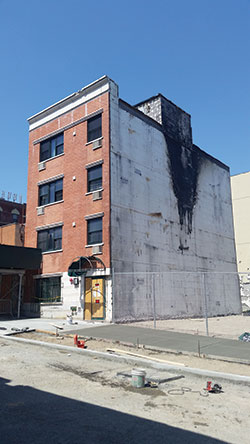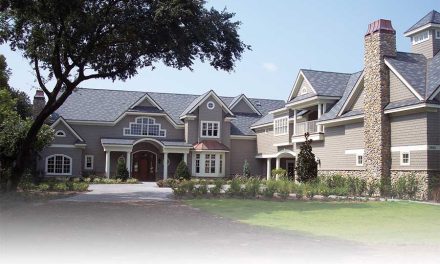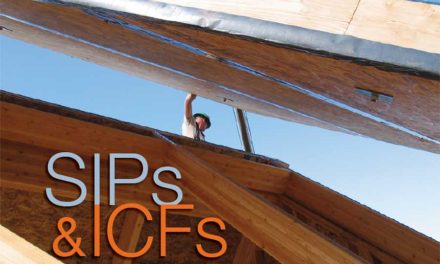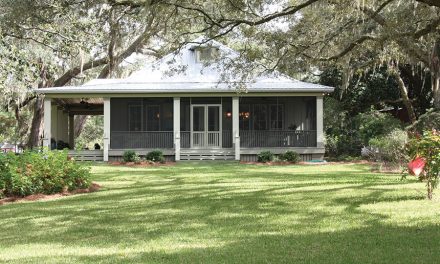ICF structures have gained a well-deserved reputation for surviving all types of natural disasters. With a solid core of steel-reinforced concrete sandwiched between two layers of shock-absorbing foam, they can resist hurricane-force winds, wildfires, earthquakes, and the ravages of time, while at the same time saving energy and looking great.
In addition to natural disasters, ICFs also have a remarkable track record standing up to man-made calamities. Over the past few years, I’ve collected a few real-life cases of lives being saved from disasters ranging from accidental fires to speeding automobiles because of ICF walls.
The U.S. military is using ICFs to construct barracks, shooting ranges, warehouses, and office buildings because of their disaster resistance. Several survival-minded homeowners have even used ICF to create houses capable of withstanding all-out nuclear war.
Standing Up to Fire
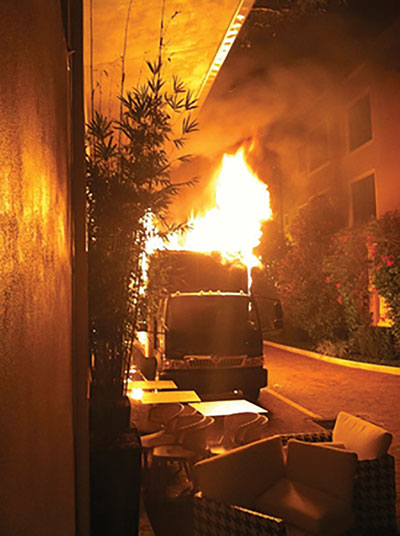
When a fire broke out at the celebratory grand opening of the New American Home, ICF walls protected the occupants and the million-dollar artwork inside, while minimizing damage to the building.
Of all disasters—natural and man-made—fire is by far the most common and the most deadly. The U.S. Fire Administration reports that every year, fire kills more Americans than all natural disasters combined. In 2015, fire departments battled 1.3 million house fires, which resulted in 3,280 civilian fatalities, 15,700 civilian fire injuries and an estimated $14.3 billion in direct property damage.
ICF walls have a solid core of reinforced concrete, which greatly reduces the danger from fire. Concrete has resisted fires so well, over so many years, that many insurance companies offer a masonry discount on home insurance. ICF homes qualify for this discount, which is typically 10% to 15%.
The EPS foam on each side of the concrete face contributes no fuel to a fire, and the Southwest Pacific Research Institute found that emissions from melting polystyrene are “no more toxic” than wood smoke. Most ICF walls have a fire rating of 3 to 4 hours.
Of course, homeowners can further fortify their homes by using fire-resistant interior and exterior finishes. These include steel framing on interior walls and trusses, cement-based siding or stucco, and fire-resistant roofing.
Perhaps the most dramatic example of an ICF home standing up to accidental fire occurred in 2012. The 2012 New American Home in Las Vegas was a showcase ICF project built in advance of the annual International Builders Show.
On the night before the official opening, designer Phil Keen held a catered celebratory event, and the catering truck—parked just a few feet from the side of the home—suddenly exploded into flames.
Fortunately, the wall was built with Logix’s Platinum Series ICF, which carries a four-hour fire rating, and was left undamaged, as were the paintings hanging on the other side of the ICF wall. The paintings were on loan from a museum and valued at more than one million dollars.
About ten years ago in Kansas City, Kansas, an arsonist threw a gasoline-filled firebomb onto the front porch of a newly completed Habitat for Humanity home, just days before the new owners were set to move in.
When firefighters arrived, they found that the fire had spread 12 to 15 feet along the front of the house, but as the exterior walls were built from ICF and sheathed in fiber-cement siding, there was no fuel for the fire and it was easily extinguished.
Dennis Cranor, the arson investigator, says that the damage was minimal compared to what would have happened with a wood frame house. The local ABC news affiliate reported, “If the house had been wood, it would have been a total loss.”
As it stood, repairs cost less than $500.
Unmoved By Collisions
ICF homes have also saved occupants from collisions.
Mary Heacock and her family live in the town of Hansville, Wa. a small community located on the shores of Puget Sound northwest of Seattle. The Heacock’s home was built with Quad-Lock ICFs, and they have enjoyed the benefits for more than a decade, primarily in the form of lower heating and cooling costs. But they learned of another advantage late one August night when, at about 3:50 a.m., an SUV came racing down the hill in front of their home. Unable to navigate the sharp turn at the bottom, the Ford Explorer bounced over the curb and plowed though the yard, crashing through railings and upending flower pots before smashing into the house.
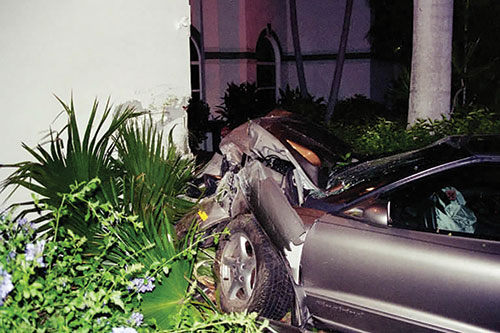
In 2005, an out-of control car traveling 90-mph hit a Florida ICF home. Damage was limited to a few square feet of exterior finish.
Heacock says that while they saw lights outside and “the whole neighborhood” heard the car, they didn’t feel it inside. In fact, video footage from Heacock’s security cameras shows the car more or less bounced off the house.
“We never thought we’d have to fend off invading cars,” she says. (The film can be viewed via our website, www.icfmag.com.)
The 24-year-old driver was transported to the hospital, but fortunately, no one else was injured. Damage to the home was limited a small area of siding and a few small chips of concrete.
“Had this been stick construction, we absolutely would have lost our house today,” Heacock told reporters.
Amazingly, a family in Florida had a nearly identical experience. Ray Demczyk of Cape Coral, Fla., was awakened at 2 a.m. a few years ago by a dull thud. He got up, intending to find whatever had fallen, only to find a set of headlights just inches from his living room window.
According to police reports, a Pontiac Firebird was racing through their neighborhood at more than 90 miles per hour when the driver lost control of the vehicle, left the roadway and slammed into the exterior wall of Demczyk’s home. Alcohol was a factor in the crash.
The ICF wall had reduced the sound of the deafening crash to a barely audible thud.
“I believe the ICF wall saved my life,” says Demczyk. “I have known that this house was solid since the day I built it. Strength, wind resistance, and insulation are the reasons I chose ICF.”
Though the car was completely totaled, thankfully, the driver survived the collision without major injuries. Damage to the home was limited to a 3’ x 5’ section of exterior finish that had been crushed by the impact.
Military Applications
The ability of ICF construction to withstand otherwise devastating impacts has not gone unnoticed by the U.S. Military. In 2003, they conducted a series of blast tests at the Quantico Marine Base outside of Washington D.C. Fifty-pound charges of TNT were detonated at varying distances from 10’x10’ ICF “reaction boxes” with a nominal 6” concrete core filled with regular 4,000 psi concrete. Horizontal and vertical rebar was placed every 16 inches. While frame walls were obliterated 35 ft. from the explosion, ICF walls survived explosions as close as six feet with only moderate damage. On the closest blast, the 50-pound charge created a ball of fire approximately 200 feet wide and 100 feet tall. The explosion melted away the foam and created several small cracks—less than 2 mm in width—on the front face of the ICF wall, but there was no deflection or structural damage to the concrete itself. Analysis indicated that EPS foam absorbed the force of the blast and prevented spalling concrete from spraying like shrapnel. (See a video of the explosions on our website, www.icfmag.com.) Follow-up blast testing in 2007 and ballistics testing a few years later showed ICFs could also withstand sustained fire from a 50-caliber machine gun.
Based on those results, ICFs are now being used for military construction projects across the United States and the Middle East, including the Pierce County Readiness Center profiled on p. 18 of this issue.
“Since September 11th, all military buildings must have force protection built in,” explains one executive. “ICF construction is the most cost effective way to achieve that.”
Blast-Resistance
In rare cases, ICF’s blast-resistance has proven useful in the civilian world. In 2014, a massive natural gas explosion ripped through a quiet neighborhood in East Harlem, New York City. The blast leveled two apartment buildings, killed eight people and injured at least 70 others. The force of the explosion shattered windows blocks away.
Through it all, the four-story ICF building adjacent to the explosion stood strong.
Owner Steve Bluestone was told by the New York Building Department, that amazingly, “there was no structural damage at all.” The engineer’s report states the blast was located “inches, not feet” from the ICF walls, yet the building was in remarkably good shape. The cellar of the building, housing the boiler, hot water heater, laundry equipment, water booster pump, and a fire pump came through without any damage whatsoever.
Unfortunately, the neighboring buildings contained lead paint and asbestos which coated the entire neighborhood. Making matters worse, the destroyed buildings were taller than Bluestone’s, and the falling masonry damaged the roof membrane, which led to significant water damage during the firefighting efforts, which required the combined efforts of more than 250 firefighters.
Explosions are more common that one might think. In 2013, an industrial accident at a fertilizer plant in West, Texas led to an enormous explosion that destroyed much of the town. The school district lost three of its four campuses, including the high school and middle school.
In rebuilding the town to a higher standard, West Integrated School District chose to rebuild the combined middle and high school with ICFs, in part due to their ability to withstand explosions. This school is profiled on the following pages.
ICF walls are solid. Whether the threat is explosion, arson, a high-speed car collision, or a massive charge of TNT, actual field results demonstrate that ICFs have what it takes to protect occupants and their belongings.
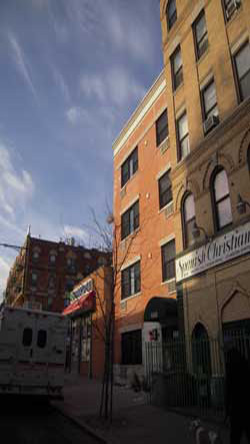
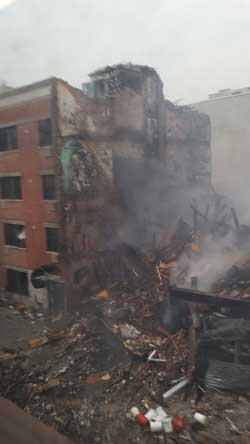
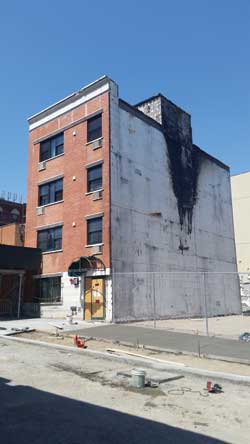
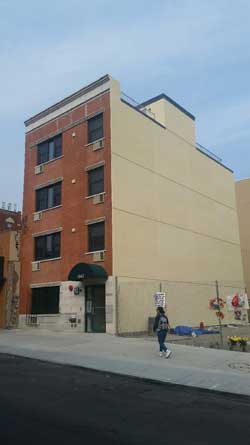
This series of shots show the building before the accident, immediately afterwards, post-clean-up, and ready for occupancy.

